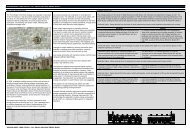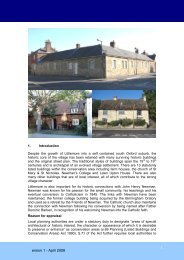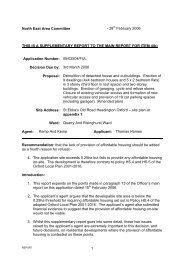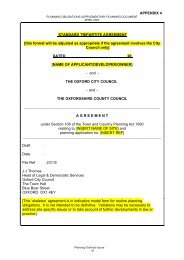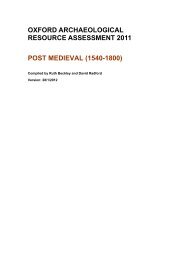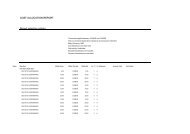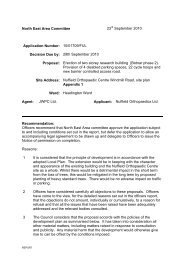Palaeolithic to Mesolithic Oxford (500000 - 4000 BC) - Oxford City ...
Palaeolithic to Mesolithic Oxford (500000 - 4000 BC) - Oxford City ...
Palaeolithic to Mesolithic Oxford (500000 - 4000 BC) - Oxford City ...
Create successful ePaper yourself
Turn your PDF publications into a flip-book with our unique Google optimized e-Paper software.
contains deposits dating <strong>to</strong> the period c. 350,000-250,000 BP, covering MIS 10-8.<br />
The Wolvercote Terrace produced an important collection of <strong>Palaeolithic</strong> artefacts<br />
from the lower part of the Wolvercote Channel deposits, recovered from the<br />
Wolvercote Brick Pit when it was open in the late 19 th and early 20 th century,<br />
comprising numerous pointed handaxes with a distinctive plano-convex crosssection,<br />
as well as waste debitage (Roe 1981: 118-128). The mint condition of many<br />
of them suggests they were recovered from an undisturbed occupation horizon<br />
associated with the interglacial conditions at the base of the Wolvercote Channel<br />
sequence. It is also notable that a high proportion of the handaxes are made of flint,<br />
a scarce raw material in the vicinity, and thus indicating targeted collection of the<br />
most suitable raw material, possibly imported from a substantial distance. There are<br />
also reports of occasional finds and faunal remains from higher up the sequence, in<br />
deposits associated with cooler conditions. The Wolvercote Terrace thus contains, in<br />
its Wolvercote Channel facies, rare evidence of undisturbed <strong>Palaeolithic</strong> occupation<br />
in conjunction with mammalian remains and other palaeo-environmental evidence<br />
that can make a significant contribution <strong>to</strong> current research priorities, both regionally<br />
in the Thames basin and the Solent-Thames area (Wenban-Smith et al. 2010), and<br />
nationally in the UK (English Heritage 2008).<br />
Subsequent <strong>to</strong> completion of work in the Wolvercote Brick pit early in the 20 th<br />
century, a number of attempts have been made <strong>to</strong> relocate and reinvestigate the<br />
Wolvercote Channel deposits (Briggs et al. 1985; Bridgland & Harding 1986). These<br />
have, however, been generally unsuccessful. Bridgland and Harding cleared a series<br />
of sections along the railway cutting that runs north-south immediately <strong>to</strong> the east of<br />
the site, but failed <strong>to</strong> find any sign that the Wolvercote Channel deposits extended in<br />
this direction beyond the footprint of the old brick pit. They did, however, find remnant<br />
pockets of the Wolvercote Gravel lying in the <strong>Oxford</strong> Clay bedrock, corresponding<br />
with reports (Pocock 1908: 89) of gravel in "holes in the <strong>Oxford</strong> Clay" on the western<br />
side of the old Wolvercote Brick Pit, <strong>to</strong>wards the railway. It is however uncertain<br />
whether the Wolvercote Channel was genuinely a channel, and thus might be<br />
expected <strong>to</strong> extend as a continuing feature beyond the brick pit, or whether the<br />
"channel" deposits filled intermittent pockets overlying, and in places cutting through,<br />
the Wolvercote Gravel, and thus could be present almost anywhere above mapped<br />
outcrops of Terrace 3.<br />
The Radcliffe Infirmary site<br />
A recent geo-archaeological assessment carried out by Museum of London<br />
Archaeology on samples taken from the Radcliffe Infirmary site was intended <strong>to</strong><br />
examine the potential there for Lower/Middle <strong>Palaeolithic</strong> evidence within the<br />
Summer<strong>to</strong>wn-Radley Gravel Formation (Ruddy 2009: 1). Three phases of braided<br />
river development were recorded, indicated by coarse grained gravel sediments,<br />
interspersed with lower energy channel flow, or episodes of standing water (as<br />
indicated by fine grained sediments). The majority of the gravel beds were initially<br />
thought <strong>to</strong> correlate with the Stan<strong>to</strong>n Harcourt Gravel (MIS 6). However, three OSL<br />
dates obtained from the fine grained material led <strong>to</strong> a reappraisal of the chronology.<br />
Two OSL samples were taken from the fine grained sediment at a height of 60.83m<br />
OD and produced a date of 86.10+/- 9.19 Ka BP, and 76.12 +/- 26.22 Ka BP.<br />
Another OSL date was taken at an elevation of 61m OD and produced a date of<br />
95.66 +/- 13.5 Ka BP. These dates would suggest that a longer chronology of<br />
lithostratigraphy survives on the site than previously believed. The OSL dates fall<br />
within the Early Devensian period leading <strong>to</strong> the association of the upper gravel units<br />
with the Northmoor Gravel member. The lower units may therefore form part of not<br />
only the Stan<strong>to</strong>n Harcourt Gravel (MIS 6) but also the Eynsham Gravel (MIS 5e)<br />
(Braybrooke 2010: 74).<br />
OXFORD ARCHAEOLOGICAL RESOURCE ASSESSMENT- PALAEOLITHIC TO<br />
MESOLITHIC 8



